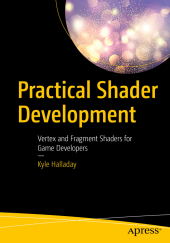 Neuerscheinungen 2019Stand: 2020-02-01 |
Schnellsuche
ISBN/Stichwort/Autor
|
Herderstraße 10
10625 Berlin
Tel.: 030 315 714 16
Fax 030 315 714 14
info@buchspektrum.de |

Kyle Halladay
Practical Shader Development
Vertex and Fragment Shaders for Game Developers
1st ed. 2019. xxi, 381 S. 23 SW-Abb., 136 Farbabb., 50 Farbtabellen. 254 mm
Verlag/Jahr: SPRINGER, BERLIN; APRESS 2019
ISBN: 1-484-24456-7 (1484244567)
Neue ISBN: 978-1-484-24456-2 (9781484244562)
Preis und Lieferzeit: Bitte klicken
It´s time to stop thinking that shaders are magical. You can use shaders to turn data into stunning visual effects, and get your hands dirty by building your own shader with this step-by-step introduction to shader development for game and graphics developers. Learn how to make shaders that move, tint, light up, and look awesome, all without cracking open a math textbook.
Practical Shader Development teaches the theory behind how shaders work. The book also shows you how to apply that theory to create eye-popping visual effects. You´ll learn to profile and optimize those effects to make sure your projects keep running quickly with all their new visuals. You´ll learn good theory, good practices, and without getting bogged down in the math.
Author Kyle Halladay explains the fundamentals of shader development through simple examples and hands-on experiments. He teaches you how to find performance issues in shaders you are using and then how to fix them. Kyle explains (and contrasts) how to use the knowledge learned from this book in three of the most popular game engines today.
What You´ll Learn
Understand what shaders are and how they work
Get up to speed on the nuts and bolts of writing vertex and fragment shaders
Utilize color blending and know how blend equations work
Know the coordinate spaces used when rendering real-time computer graphics
Use simple math to animate characters, simulate lights, and create a wide variety of visual effects
Find and fix performance problems in shaders
See how three popular game engines (Unity, UE4, Godot) handle shaders
Who This Book Is For
Programmers who are interested in writing their own shaders but do not know where to start, anyone who has ever seen shader code on a forum and wished they knew how to modify it just a little bit to fit into their own projects, and game developers who are tired of using the default shaders found in the game engines they are using. The book is especially useful for those who have been put off by existing shader tutorials which introduce complex math and graphics theory before ever getting something on the screen.
1. Hello, Game Graphics 2. Your First Shaders 3. Using Textures 4. Translucency and Depth 5. Making Things Move 6. Cameras and Coordinates 7. Your First 3D Project 8. Diffuse Lighting 9. Your First Lighting Model 10. Normal Mapping 11. Cubemaps and Skyboxes 12. Lighting In Depth 13. Profiling Shaders 14. Optimizing Shaders 15. Precision 16. Writing Shaders in Unity 17. Writing Shaders in UE4 18. Writing Shaders in Godot 19. Appendix A. Important Code Snippets
Kyle Halladay is a professional game programmer living in Chicago. He has more than seven years of experience writing about shaders and building graphics technology for games and architectural visualizations.


